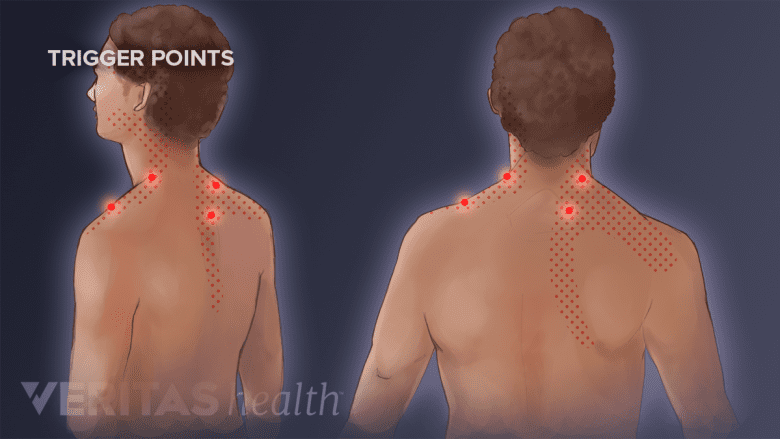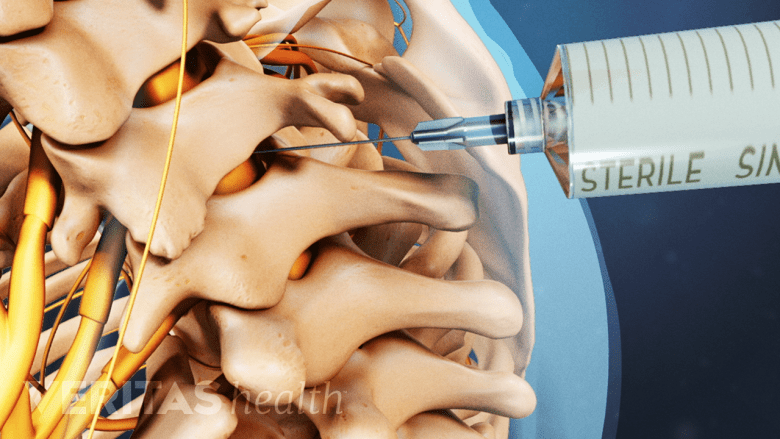A herniated disc cannot be repaired or healed back to a normal state, so the primary goal of treatment is to minimize pain until the inflammatory proteins dry out and symptoms subside. Typically, nonsurgical treatment options will be tried for at least 6 to 12 weeks. If nonsurgical treatments are not providing relief and neurological deficits persist or worsen, such as numbness or weakness in the arm, surgery for a cervical herniated disc may be considered as a last option.
In This Article:
- Cervical Radiculopathy from a Herniated Cervical Disc
- Cervical Radiculopathy from a Herniated Disc Treatment Options
- Surgical Options for Cervical Radiculopathy from a Herniated Cervical Disc
- Cervical Radiculopathy Interactive Video
Cervical Radiculopathy Self-Care
When intense symptoms of cervical radiculopathy flare up, such as electrical shock-like shooting pains down the arm, a few self-care options might help control the pain:
Ice therapy

Ice therapy may help alleviate neck pain by reducing inflammation.
Applying ice within the first 24 to 48 hours of a flare-up can help minimize inflammation, which can be a source of pain. If it helps, a person can lay down on the back and place a wrapped ice pack beneath the neck or shoulder as an easy way to keep it there for 10 to 20 minutes at a time. However, care must be taken to avoid falling asleep, which could lead to overexposure and skin damage.
Over-the-counter pain medications
Nonsteroidal anti-inflammatory medications (NSAIDs), such as ibuprofen and naproxen, can treat inflammation and pain.
Rest
Limiting movement, or at the very least avoiding movements that make the pain worse, can be beneficial when pain first flares. However, extended rest (more than a couple days) is not recommended because that could lead to the neck becoming weaker and stiffer, which can promote more discomfort.
These treatments might not make the symptoms go away completely, but they can help manage the pain until either the symptoms subside or a longer-term treatment plan can be obtained from a doctor.
Cervical Radiculopathy Medical Treatments
If cervical radiculopathy symptoms cannot be adequately relieved with self-care, a doctor or other qualified medical professional can help with:
Physical therapy
An exercise and stretching program may provide relief by helping the patient to have better posture, as well as stronger and more flexible muscles that are less prone to painful spasms. A physical therapy program could also include manual manipulation, which may be able to temporarily relieve pain or loosen joints to help continue with the exercise program.
See Physical Therapy for Neck Pain Relief
Prescription pain medications

Prescription medications may reduce neck pain in the short term.
Prescription-strength muscle relaxants or narcotics (opioids) might provide better pain relief if over-the-counter options have not worked. However, prescription painkillers usually should not be taken for more than a couple weeks because of potential side effects, including addiction.
Heat and/or cold therapy

Heat and ice therapy may help alleviate neck or arm pain.
Applying heat to the neck or other sore area can provide relief for some people. Typically, ice should be used during the first day or two (no more than 20 minutes at a time) because it can help prevent inflammation. After that initial period, heat or ice can be used depending on the patient’s preference.
Massage therapy

Manual manipulation aims to improve mobility and reduce stiffness in the back.
Some people experience relief from a massage, which can relax muscles, increase blood flow, and release feel-good endorphins.
Manual traction
A machine can be used in a doctor’s office or physical therapy setting to gently lift the head and help open up the cervical spine’s foramina, where the nerve roots exit the spinal canal. If this therapy helps relieve pain, a home traction unit can be prescribed. Traction should be initiated under a physical therapist’s or other qualified medical professional’s supervision.
See Specific Manual Physical Therapy Techniques
Epidural injections

A cervical epidural steroid injection may provide pain relief by reducing inflammation.
A medical professional can inject a steroid medication directly into the epidural region of the cervical spine, which may provide some short-term relief. This option is typically only tried after other non-surgical options have been deemed unsuccessful.
This list does not include every possible treatment for cervical radiculopathy from a herniated disc. One particular treatment option, or combination of treatment options, might work well for one person but not another.

